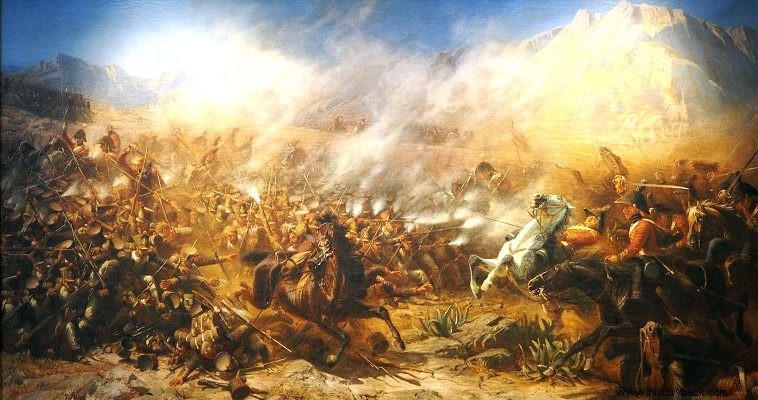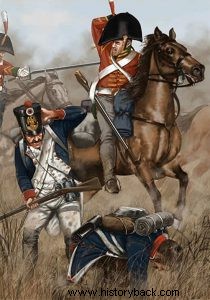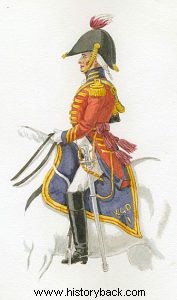
Napoleonic squares have become famous since the Battle of Waterloo, when British and Allied infantry handily repulsed massed French cavalry charges. However, the square formation, as most people have it in mind, was much older and was used in the 17th and 18th centuries. Of course we are not talking about the Renaissance or antiquity when the formation was used in abundance. However, the Napoleonic square was not patchwork and there are examples of it being broken by the opposing cavalry. The most characteristic of these was probably the battle at García Hernández, south of Salamanca in Spain.
On July 22, 1812 the allied army (British, German, Portuguese and Spanish) of the Duke of Wellington defeated the French army of Marshal Marmont. The French having lost over 13,000 men retreated badly. A brigade of them under Major-General Maximilian Foy, 4,000 strong consisting of two battalions of the 6th Light Infantry Regiment (LIP), two battalions of the 39th Line Infantry Regiment (LIP), two of the 69th LIP and two of the 76th, formed the rear guard of the defeated French army. This brigade was reinforced with the cavalry division of Brigadier Courtois, which had 19 light, overworked, islands.
Wellington, however, did not let the enemy retreat unmolested. Ordered the German Major General of the German Legion of King Eberhard Otto Georg von Bock to pursue with his cavalry brigade the French. The Bock Brigade had two German regiments, the 1st and 2nd Heavy Dragoon Regiments of the German Legion. The two regiments together mustered only 770 men.
A little later, however, Wellington decided to reinforce Bock with Major General George Anson's British Light Cavalry Brigade (11th, 12th and 16th Light Dragoon Regiments), about 1,000 strong. Bock moved at maximum speed and the next day, July 23, he located the French rear guard near the small village of Garcia Hernandez, 30 km from Salamanca.
In the position of the allied cavalry, Courteau and his horsemen stood briefly against Anson's British, but then fled in disgrace, abandoning their infantry colleagues of Foy. The latter on sight of the enemy's cavalry ordered his men to form squares by battalion. Thus, eight French squares were formed on an adjacent barren hill.
Bock, when he saw the French squares, did not hesitate. He immediately marched with his Germans to the nearest enemy block of a battalion of the 6th ESPZ. The French did not fire directly at the enemy but held their fire in order to fire when the Germans would have come very, very close. This was also their mistake. When they finally charged they did kill and wound several enemy cavalry and horses, but the Germans had come so close that a wounded horse carrying its dead rider fell upon the French infantry.
The badly wounded horse crushed at least six Frenchmen. In this way, a "hole" was created in the French quarter which, of course, Bock and his men took advantage of. Like a wave the Germans charged with their straight long swords against the French, slaughtering many in a matter of moments. Hilarch Gleisen was the first to appear with his ili. The French quarter broke up and more men surrenderedto him . The others were crushed. But the worst would follow.
Immediately after their initial success the Germans charged against a second French square. No wounded horse was needed this time. The morale of the French had so collapsed that the block broke up before contact with the enemy. What the Germans simply had to do was to hunt, like hares, and capture, or kill the panicked, defenseless pedestrians.
The Germans also attacked a third French block which was also nearly broken up by panic, but finally, by the intervention of the officers, it finally held, although it suffered losses in killed, wounded and prisoners. Many of the French panicked and made a beeline now being pursued by Anson's light cavalry who, after the flight of the French cavalry, had no opponent. The battle lasted less than 30 minutes and resulted in over 200 French killed and over 1,400 captured. The rest of the French were rescued guided by their commander. The losses of the victors were light, amounting to 116 dead and wounded. Most of the dead fell from the first French bombardment.
The breaking up of a square was not an ordinary thing and could happen either by some random event, or by an error of the head of the square (in relation to the time of launching the defensive fires), or by the morale of the soldiers who formed it. In the battle of García Hernández, all three of these factors are found.
In a corresponding case in Germany, in 1809, the Black Braunschweiger cavalry he broke up blocks of Westphalian infantry that were dramatically lacking in training. Another instance was at the Battle of Albuera, 1811, and Cat Bra, 1815, when the French surprised Wellington's infantry divisions. Unfortunately, fortune played a bad game on the winner von Bock who drowned, in 1814, together with his son Ludwig when the ship carrying them to Britain from Spain was wrecked. It is worth noting that Bock was nearsighted and before the attack he asked his officers to show him where the enemy was!

A German dragoon ready to strike a blow with his sword at a French infantryman.

Officer of the 1st Heavy Dragoon Regiment of the King's German Legion.
